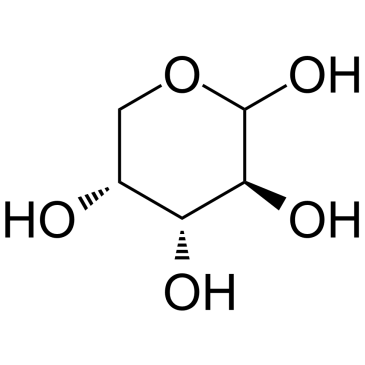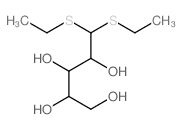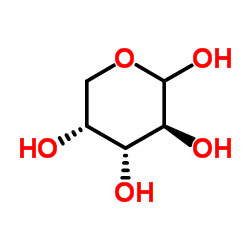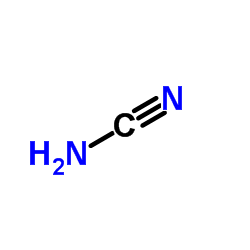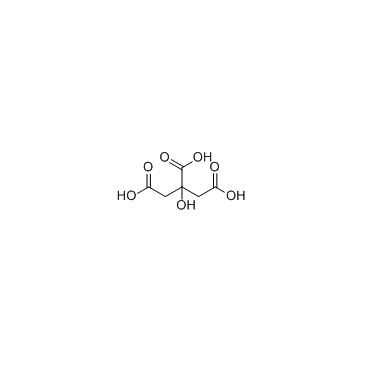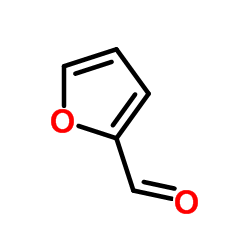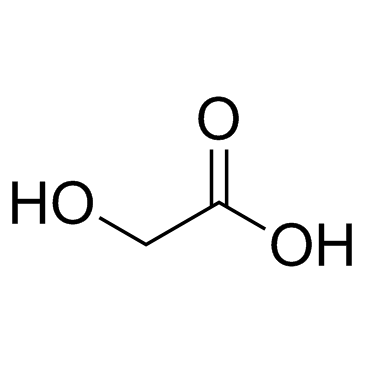28697-53-2
| 中文名 | D-阿拉伯糖 |
|---|---|
| 英文名 | D(-)-Arabinose |
| 中文别名 | D-(-)-树胶醛糖 |
| 英文别名 |
EINECS 233-708-5
MFCD00064361 Arabinose arabinopyranose D-arabinose |
| 描述 | D-Arabinose 是一种单糖,对秀丽隐杆线虫有较强的生长抑制作用,其 IC50 值为 7.5 mM。 |
|---|---|
| 相关类别 | |
| 参考文献 |
| 密度 | 1.8±0.1 g/cm3 |
|---|---|
| 沸点 | 333.2±42.0 °C at 760 mmHg |
| 熔点 | 152-160ºC |
| 分子式 | C5H10O5 |
| 分子量 | 150.130 |
| 闪点 | 155.3±27.9 °C |
| 精确质量 | 150.052826 |
| PSA | 90.15000 |
| LogP | -0.83 |
| 外观性状 | 白色结晶粉末 |
| 蒸汽压 | 0.0±1.6 mmHg at 25°C |
| 折射率 | 1.646 |
| 储存条件 | 密封、在温室保存 |
| 稳定性 | 常温常压下稳定 |
| 计算化学 | 1、 疏水参数计算参考值(XlogP):-2.5 2、 氢键供体数量:4 3、 氢键受体数量:5 4、 可旋转化学键数量:0 5、 互变异构体数量: 6、 拓扑分子极性表面积(TPSA):90.2 7、 重原子数量:10 8、 表面电荷:0 9、 复杂度:117 10、 同位素原子数量:0 11、 确定原子立构中心数量:4 12、 不确定原子立构中心数量:0 13、 确定化学键立构中心数量:0 14、 不确定化学键立构中心数量:0 15、 共价键单元数量:1 |
| 更多 | 1. 性状:无味的白色晶体 2. 密度(g/mL,25℃):未确定 3. 相对蒸汽密度(g/mL,空气=1):1.585 4. 熔点(ºC):162-164 5. 晶相相标准燃烧热(焓)(kJ·mol-1):-2338.8 6. 晶相标准声称热(焓)( kJ·mol-1):-1057.9 7. 折射率:n20/D 1.585 8. 闪点(ºC):. 未确定 9. 比旋光度(º):-103.5 10. 自燃点或引燃温度(ºC):未确定 11. 蒸气压(Pa,20ºC):未确定 12. 饱和蒸气压(KPa,20ºC):未确定 13. 燃烧热(KJ/mol):未确定 14. 临界温度(ºC):未确定 15. 临界压力(KPa):未确定 16. 油水(辛醇/水)分配系数的对数值:未确定 17. 爆炸上限(%,V/V):未确定 18. 爆炸下限(%,V/V):未确定 19. 溶解性:水:20ºC ,1M,澄清,无味 |
Synonym:None known Section 2 - COMPOSITION, INFORMATION ON INGREDIENTS
Risk Phrases: None Listed. Section 3 - HAZARDS IDENTIFICATION EMERGENCY OVERVIEW
The toxicological properties of this material have not been fully investigated. Potential Health Effects Eye: May cause eye irritation. Skin: May cause skin irritation. May cause erythema (redness) and edema (fluid buildup) with crusting and scaling. Ingestion: May cause gastrointestinal irritation with nausea, vomiting and diarrhea. The toxicological properties of this substance have not been fully investigated. Inhalation: May cause respiratory tract irritation. The toxicological properties of this substance have not been fully investigated. Chronic: No information found. Section 4 - FIRST AID MEASURES Eyes: Flush eyes with plenty of water for at least 15 minutes, occasionally lifting the upper and lower eyelids. Get medical aid. Skin: Get medical aid. Flush skin with plenty of water for at least 15 minutes while removing contaminated clothing and shoes. Wash clothing before reuse. Ingestion: Never give anything by mouth to an unconscious person. Get medical aid. Do NOT induce vomiting. If conscious and alert, rinse mouth and drink 2-4 cupfuls of milk or water. Inhalation: Remove from exposure and move to fresh air immediately. If not breathing, give artificial respiration. If breathing is difficult, give oxygen. Get medical aid. Notes to Physician: Section 5 - FIRE FIGHTING MEASURES General Information: As in any fire, wear a self-contained breathing apparatus in pressure-demand, MSHA/NIOSH (approved or equivalent), and full protective gear. During a fire, irritating and highly toxic gases may be generated by thermal decomposition or combustion. Non-combustible, substance itself does not burn but may decompose upon heating to produce irritating, corrosive and/or toxic fumes. Extinguishing Media: Substance is noncombustible; use agent most appropriate to extinguish surrounding fire. Use water spray, dry chemical, carbon dioxide, or appropriate foam. Section 6 - ACCIDENTAL RELEASE MEASURES General Information: Use proper personal protective equipment as indicated in Section 8. Spills/Leaks: Vacuum or sweep up material and place into a suitable disposal container. Clean up spills immediately, observing precautions in the Protective Equipment section. Avoid generating dusty conditions. Provide ventilation. Section 7 - HANDLING and STORAGE Handling: Wash thoroughly after handling. Use with adequate ventilation. Minimize dust generation and accumulation. Avoid contact with eyes, skin, and clothing. Keep container tightly closed. Avoid ingestion and inhalation. Storage: Store in a tightly closed container. Store in a cool, dry, well-ventilated area away from incompatible substances. Section 8 - EXPOSURE CONTROLS, PERSONAL PROTECTION Engineering Controls: Facilities storing or utilizing this material should be equipped with an eyewash facility and a safety shower. Use adequate ventilation to keep airborne concentrations low. Exposure Limits CAS# 28697-53-2: Personal Protective Equipment Eyes: Wear appropriate protective eyeglasses or chemical safety goggles as described by OSHA's eye and face protection regulations in 29 CFR 1910.133 or European Standard EN166. Skin: Wear appropriate protective gloves to prevent skin exposure. Clothing: Wear appropriate protective clothing to prevent skin exposure. Respirators: A respiratory protection program that meets OSHA's 29 CFR 1910.134 and ANSI Z88.2 requirements or European Standard EN 149 must be followed whenever workplace conditions warrant respirator use. Section 9 - PHYSICAL AND CHEMICAL PROPERTIES Physical State: Crystalline powder Color: white crystalline powder Odor: none reported pH: Not available. Vapor Pressure: Not available. Viscosity: Not available. Boiling Point: Not available. Freezing/Melting Point: 162-164C Autoignition Temperature: Not applicable. Flash Point: Not applicable. Explosion Limits, lower: Not available. Explosion Limits, upper: Not available. Decomposition Temperature: Solubility in water: Soluble. Specific Gravity/Density: Molecular Formula: C5H10O5 Molecular Weight: 150.067 Section 10 - STABILITY AND REACTIVITY Chemical Stability: Stable at room temperature in closed containers under normal storage and handling conditions. Conditions to Avoid: Incompatible materials, dust generation, excess heat. Incompatibilities with Other Materials: Oxidizing agents. Hazardous Decomposition Products: Carbon monoxide, irritating and toxic fumes and gases, carbon dioxide. Hazardous Polymerization: Has not been reported Section 11 - TOXICOLOGICAL INFORMATION RTECS#: CAS# 28697-53-2 unlisted. LD50/LC50: Not available. Carcinogenicity: D-(-)-Arabinose - Not listed by ACGIH, IARC, or NTP. Section 12 - ECOLOGICAL INFORMATION Section 13 - DISPOSAL CONSIDERATIONS Dispose of in a manner consistent with federal, state, and local regulations. Section 14 - TRANSPORT INFORMATION IATA Not regulated as a hazardous material. IMO Not regulated as a hazardous material. RID/ADR Not regulated as a hazardous material. Section 15 - REGULATORY INFORMATION European/International Regulations European Labeling in Accordance with EC Directives Hazard Symbols: Not available. Risk Phrases: Safety Phrases: S 28A After contact with skin, wash immediately with plenty of water. S 37 Wear suitable gloves. S 45 In case of accident or if you feel unwell, seek medical advice immediately (show the label where possible). WGK (Water Danger/Protection) CAS# 28697-53-2: No information available. Canada None of the chemicals in this product are listed on the DSL/NDSL list. CAS# 28697-53-2 is not listed on Canada's Ingredient Disclosure List. US FEDERAL TSCA CAS# 28697-53-2 is not listed on the TSCA inventory. It is for research and development use only. SECTION 16 - ADDITIONAL INFORMATION N/A |
|
生态学数据: 若无政府许可,勿将材料排入周围环境。
|
| 安全声明 (欧洲) | S24/25 |
|---|---|
| WGK德国 | 3 |
| 海关编码 | 2940000000 |
| 上游产品 0 | |
|---|---|
| 下游产品 10 | |
| 海关编码 | 2932999099 |
|---|---|
| 中文概述 | 2932999099. 其他仅含氧杂原子的杂环化合物. 增值税率:17.0%. 退税率:13.0%. 监管条件:无. 最惠国关税:6.5%. 普通关税:20.0% |
| 申报要素 | 品名, 成分含量, 用途 |
| Summary | 2932999099. other heterocyclic compounds with oxygen hetero-atom(s) only. VAT:17.0%. Tax rebate rate:13.0%. . MFN tariff:6.5%. General tariff:20.0% |


